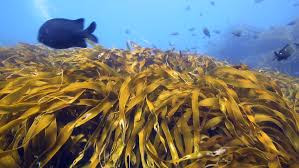- Get link
- X
- Other Apps
Call us not weeds; we are blossoms of the ocean.
Ocean growth is an especially nutritious food, which retains and thinks hints of a wide assortment of minerals important to the body's wellbeing. Numerous components may happen in ocean growth - aluminum, barium, calcium, chlorine, copper, iodine and iron, to give some examples - follows ordinarily created by disintegration and conveyed to the kelp beds by waterway and ocean flows. Kelp are additionally rich in vitamins: in reality, Eskimos get a high extent of their substantial necessities of nutrient C from the ocean growth they eat. The nutritive estimation of ocean growth has for quite some time been perceived. For example, there is an astoundingly low occurrence of goiter among the Japanese, and for that matter, among our own Maori individuals, who have consistently eaten ocean growth, and this likely could be credited to the high iodine substance of this food. Investigation into old Maori eating customs shows that jams were made utilizing ocean growth, new foods grown from the ground, fuchsia and tutu berries, cape gooseberries, and numerous different organic products which either became here normally or were planted from seeds brought by pioneers and adventurers.
New Zealand makes a case for around 700 types of ocean growth, some of which have no portrayal outside this nation. Of a few animal types become around the world, New Zealand additionally has an especially huge offer. For instance, it is evaluated that New Zealand has about 30 types of Gigartina, a nearby relative of carrageen or Irish greenery. These are frequently alluded to as the New Zealand carrageens. The gel-shaping substance called agar which can be removed from this species gives them extraordinary business application in seameal, from which seameal custard is made, and in hack blend, candy store, beautifiers, the canning, paint and calfskin enterprises, the production of copying cushions, and in toothpaste. Truth be told, during World War II, New Zealand Gigartina were sent toAustralia to be utilized in toothpaste.
However albeit New Zealand has such a large amount of the economically productive red seaweeds, a few of which are a wellspring of agar (Pterocladia, Gelidium, Chondrus, Gigartina), before 1940 moderately little utilize was made of them. New Zealand used to import the Northern Hemisphere Irish greenery (Chondrus crispus) from England and instant agar from Japan. Despite the fact that dispersion of the Gigartina is kept to specific regions as per species, it is just on the east bank of the North Island that its event is uncommon. What's more, and still, at the end of the day, the east coast, and the region around Hokiangna, have a significant flexibly of the two types of Pterocladia from which agar is additionally accessible. Cheerfully, New Zealand-made agar is currently realistic in wellbeing food shops.
Ocean growth are isolated into three classes dictated by shading - red, earthy colored and green - and each will in general live in a particular area. In any case, aside from the undeniable ocean lettuce (Ulva), few are absolutely one shading; and particularly when dry, a few animal groups can change shading fundamentally - an earthy colored one may turn very dark, or a red one seem dark, earthy colored, pink or purple. Distinguishing proof is in any case encouraged by the way that the components which determine where an ocean growth will develop are very exact, and they in this manner will in general happen in all around characterized zones. In spite of the fact that there are exemptions, the green kelp are predominantly shallow-water green growth; the browns have a place with medium profundities, and the reds are plants of the more profound water. Level stone surfaces close to mid-level tides are the most regular natural surroundings of ocean bombs, Venus' neckband and most earthy colored kelp. This is likewise the area of the purple laver or Maori karengo, which looks rather like a rosy purple lettuce. Profound water rocks on open coasts, uncovered distinctly at exceptionally low tide, are normally the site of bull kelp, lash weeds and comparable extreme examples. Those species ready to oppose significant stretches of presentation to the sun and air are normally found on the upper shore, while those less ready to stand such introduction happen closer to or underneath the low-water mark. Radiation from the sun, the temperature level, and the time span submerged all have an impact in the zoning of ocean growth.
Proliferation of ocean growth happens by spores, or by treatment of egg cells. None have establishes in the standard sense; few have leaves, and none have blossoms, organic products or seeds. The plants assimilate their sustenance through their fronds when they are encircled by water: the base or "holdfast" of ocean growth is simply an appending organ, not an engrossing one.
A portion of the enormous ocean growth keep up lightness with air-filled buoys; others, for example, bull kelp, have huge cells loaded up with air. A few, which spend a decent piece of their time presented to the air, regularly diminish drying out either by having swollen stems that contain water, or they may (like Venus' jewelry) have | swollen knobs, or they may have particular shape like an ocean bomb. Others, similar to the ocean desert plant, are loaded up with vile liquid or have covering of adhesive on % the surface. In a portion of the bigger kelps, this covering isn't just to keep the plant clammy yet in addition to shield it from the fierce activity of waves.
- Get link
- X
- Other Apps

Comments
Post a Comment